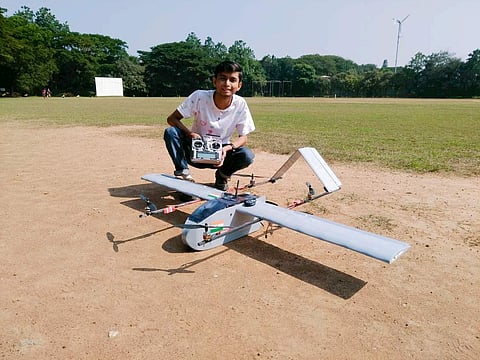

Drones are not one of man's recent inventions. Initially, they were used by the police department to capture pictures of people in crowded places for security purposes. And just a short while ago, we heard about them being used to spray pesticides. So here's the latest development, drones can now be used to transport organs from one place to another in a short span of time. Meet Rohit Dey, the 21-year-old from Bengaluru who built the Humming Bird, a drone that can carry up to 5.5 kg of load, it can be used specifically to transport organs or even medical supplies during critical hours.
Surprisingly, this isn't Rohit's first tryst with drones. Prior to this, he has worked in several projects initiated by National Aerospace Laboratories (NAL) and came to be known as the unofficial drone pilot of NAL. So, what drew him to drones? He explains, "My father works as a scientist at NAL. When I was five, we used to live near the Old Airport Road and every day, I could see many planes and helicopters fly over the roof of our house. This inspired me to work on designs and that led to a chain of innovations." Following his passion, he started building drones and UAVs when he was as young as 13 years old.
Rohit claims that till date, he has built over 90 drones and quadrotors that can be used for various purposes and they have been named after birds. So that explains the name Humming Bird! When we ask him about the idea behind developing this particular drone, he says, "Traffic jams is one of the most burning issues in India. Whenever an organ has to be transported for transplantation purpose, it takes time for the ambulance to reach the airport. In such cases, the drone can carry organs. This leads to the question, 'Where do you land a drone in a hospital?'. Unlike aeroplanes and helicopters which require a large landing space, this drone does not need that much space. I have developed the drone keeping such problems in mind."
The young scientist has also designed the drone using the principle of Vertical Takeoff Landing (VOTL), something you rarely see in UAVs. "Developing a UAV or drone on the VOTL principle is very difficult. I have worked on this project for a period of six months. Many scientists in government agencies are still trying to achieve it. Despite a lot of funding from the Central Government, they have not been successful in launching one," he says, rather proud of his achievements. He adds, "My drone design can be called a hybrid between a helicopter and an aeroplane. It flies as fast as an aeroplane and takes off like a helicopter. With the Indian stimulation frequency range of 2.4 gigahertz, the drone can cover a radius of 5 km. And with the Indian army's stimulation frequency range, it can cover up to 40 kilometres."
Rohit is still working on the drone to increase the capacity of the load from 5.5 to 12 kg. "By the end of 2019, I will be launching the next version that will be able to carry 12 kg. If I get support from the government in terms of research and development, I will be able to develop a better product that can benefit the country," he concludes.
